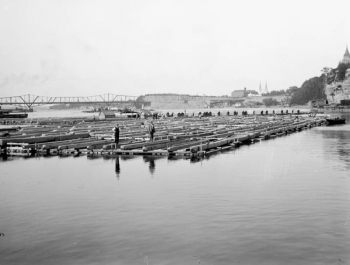8 July 1908
These days, Ottawa has become a synonym for “the government” much to the chagrin of the city’s residents. Newspapers constantly complain about things that “Ottawa” has done. This is understandable since government is the principal industry of the city. One in five jobs in the Ottawa-Gatineau area is with the federal government, a fraction that rises to one in four if you include other levels of administration. This wasn’t always the case. At the beginning of the twentieth century, trees, not politics, were central to the economic prosperity of Ottawa, and of Hull, its sister community on the other side of the Ottawa River. Saw mills and pulp and paper factories which crowded the shores of the Ottawa River, especially in the Chaudière district, employed thousands. Communities the length of the Ottawa Valley also depended on the forestry business, felling and shipping logs to Ottawa and Hull for processing.
The lumber business in the Ottawa Valley began with Philemon Wright, the man from Woburn, Massachusetts who led the first Europeans to the region, settling on the north shore of the Ottawa River in 1800 in what would later be called Hull, Quebec. The settlers, initially intent on farming, discovered a pristine forest that stretched for as far as the eye could see. By one estimate, the untouched Ottawa Valley, in which the land’s Indigenous people had liven for countless generations, comprised 28 million acres of dense woodland. The settlers quickly turned to exploiting this vast and seemingly inexhaustible resource, containing more than 500 billion board feet of valuable timber (A board foot is a measure of lumber volume, being one foot by one foot by one inch.)
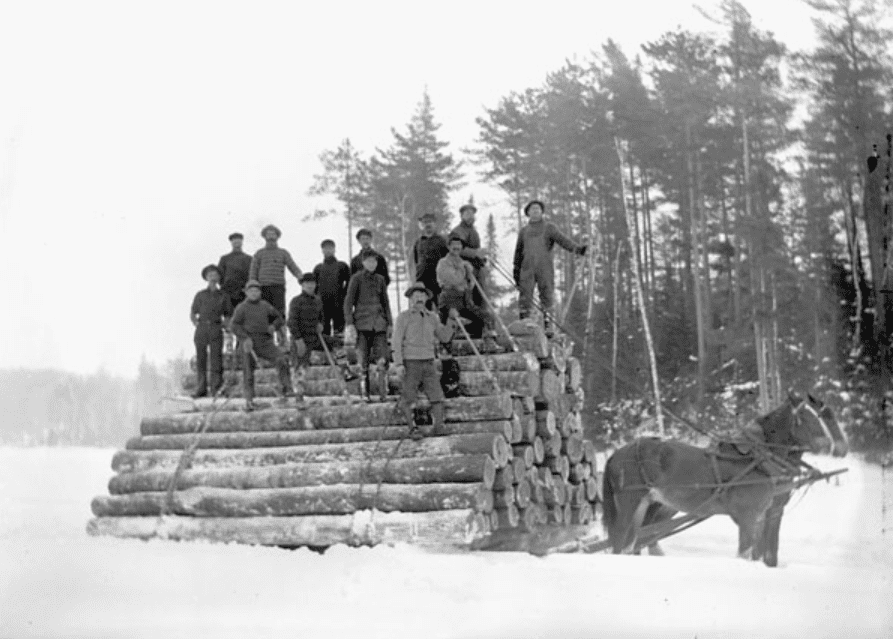 Hauling Logs in the Ottawa Valley, Topley Studio, Library and Archives Canada
Hauling Logs in the Ottawa Valley, Topley Studio, Library and Archives Canada
This ancient woodland was very different from what little remains of the Valley’s forest today. It was estimated that roughly one half of the original forest was made up of white and red pine. A further 45 per cent consisted of other soft woods, such as spruce, balsam and hemlock. The remaining 5 per cent of the woodland was maple, oak, basswood and other species of hard woods. The old-growth trees were also enormous by today’s standards, with stands of white pine rising more than 100 feet.
In June 1806, Philemon Wright navigated the first log raft, christened the Columbo, from the confluence of the Gatineau and Ottawa Rivers down the Ottawa to the St. Lawrence and on to market in Quebec City for sale to the Royal Navy. At that time, Britain was fighting Napoleon’s France. With Britain’s usual Baltic supply of Norwegian pine cut off due to a French blockade, it looked to Canada’s white (sometimes referred to as yellow) pine as a replacement. The tall, straight, first growth trees made ideal masts and spars for its naval vessels.
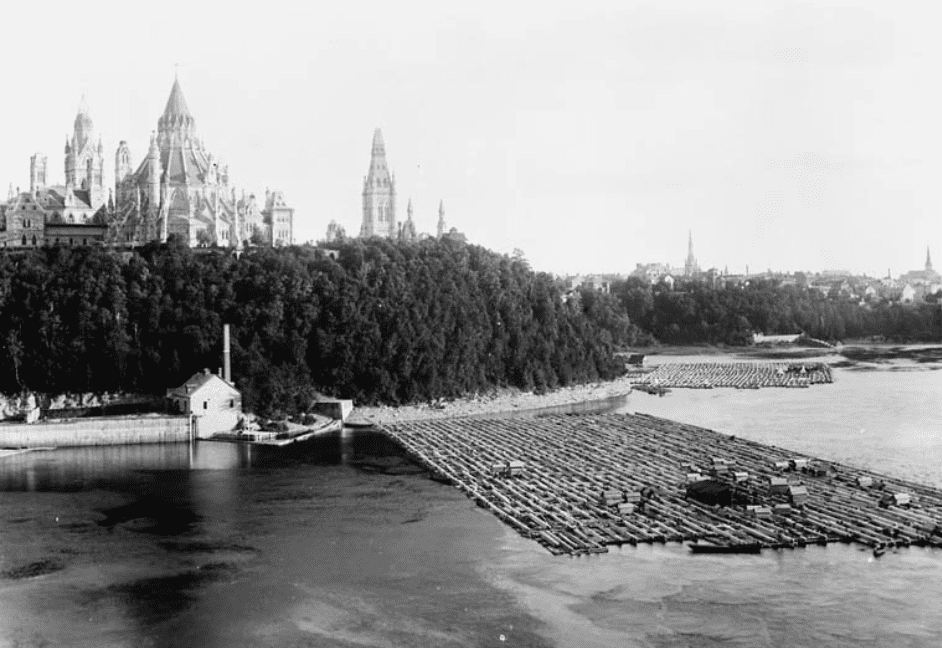 The assembling of a timber raft on the Ottawa River below Parliament Hill. Topley, Library and Archives Canada, PA-00843.
The assembling of a timber raft on the Ottawa River below Parliament Hill. Topley, Library and Archives Canada, PA-00843.
To get the timber to Quebec City, Irish and French lumbermen squared the pine logs. The “sticks,” as they were called, were pulled by teams of horses over greased slides to be launched into the water. There, they were bound together to form cribs using withes, strong, flexible branches of birch and alder. Four cribs made a band. The bands were joined together to assemble a raft. On the raft were cabins to house a crew of thirty or more men. The captain had his own quarters, sufficiently commodious to accommodate the occasional passenger. There was also a cook-house to prepare food and to brew tea.
Travelling down the Ottawa and St. Lawrence Rivers on a log raft was difficult and perilous, especially during the early days before timber slides were built so that rafts could circumvent fast water. The first such slide was built in 1829 by Ruggles Wright, the son of Philemon Wright, on the north side of the Ottawa River to pass logs around the Chaudière Falls, known in English as the Giant Cauldron. Other rapids that had to be bypassed on the way to Quebec City were found at Long Sault near Cornwall, and Lachine, both on the St. Lawrence.
Even with the construction of timber slides to ease their passage, the big rafts had to be broken down into component cribs before entering a slide, and reassembled afterwards. The journey from Ottawa to Quebec City could take a month or more. However, it wasn’t all hard work, at least for the owners. It is reported that lumber barons hosted large parties of MPs and senators to lunches of pork and beans before departing Ottawa. Also, along the way, raft captains entertained lavishly at various stops during the voyage.
Once in Quebec City, the big timber rafts were disassembled in nearby coves, and sold to waiting British merchants for shipment to Liverpool and other British ports.
In 1836, the Ottawa Valley Lumber Association was formed in Bytown, with meetings held in Doran’s Hotel, the town’s chief waterhole of the age. Early lumbermen included James Skead, David Maclaren, J.S. Currier, and the Buchanan brothers, Andrew and Charles. While the square timber trade was generally very profitable, it was also precarious. John Egan, for whom Eganville, Ontario is named, was a power in the timber trade during the mid-nineteenth century, but went bankrupt in 1854 when prices unexpectedly fell.
The era of the square timber raft peaked during the 1840s, and steadily waned thereafter. Mid-century, Britain adopted a free-trade economic policy thereby eliminating a trade preference enjoyed by Canadian timber producers since the Napoleonic Wars. The Royal Navy’s demand for Canadian pine also declined as the age of sail gave way to that of steam.
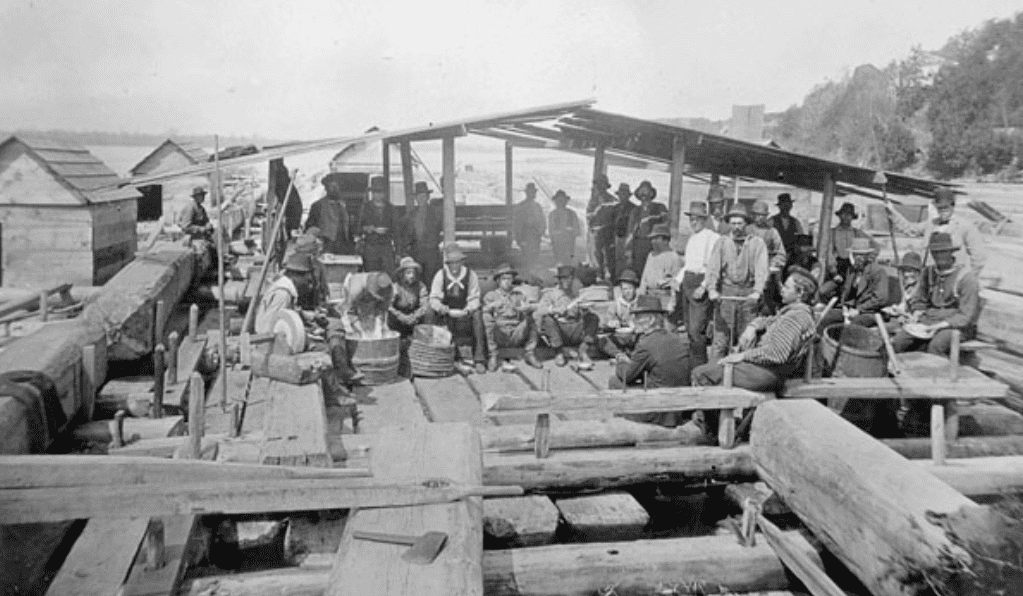 Cook house on a timber raft, Andrew Auborn Merrilees Fonds, Library and Archives Canada, ID No. 3277723.
Cook house on a timber raft, Andrew Auborn Merrilees Fonds, Library and Archives Canada, ID No. 3277723.
But Ottawa’s lumber industry adapted. Demand for Canadian sawn timber rose in the rapidly growing eastern cities of New York and Boston. U.S. entrepreneurs, such as Captain Levi Young, Franklin Bronson, Ezra Eddy, and J.R. Booth, established sawmills on the shores of the Ottawa River, harnessing its fast-flowing water to power their large timber saws. In 1874, 424 million board feet of timber were cut in Ottawa-area sawmills, along with a further 25 million board feet of square timber. The biggest lumber producer at that time was the E.B. Eddy Company whose output amounted to 55 million board feet. Close behind was Gilmour and Company which produced another 50 million board feet. J.R. Booth’s company cut a further 22 million board feet of timber.
By 1902, 613 million board feet of timber were being produced by nineteen sawmills in the Ottawa Valley. J.R. Booth had vaulted into the number one spot, producing an amazing 125 million board feet of timber. His sawmill was reportedly the largest in the world, able to produce more than 1 million board feet of sawn timber in one eleven-hour day.
As the supply of white and red pine in the Ottawa Valley rapidly diminished, Ottawa’s lumber business turned increasingly to pulp and paper production, making use of the spruce and balsam firs which hitherto had been considered of little value. In 1878, E.B. Eddy constructed the first mechanical pulp mill for the manufacture of fibre products. By 1908, E.B. Eddy was producing 160 tons of pulp every day. In 1926, Eddy built a massive sulphite chemical pulp mill in Hull immediately across the Ottawa River from the Parliament buildings.
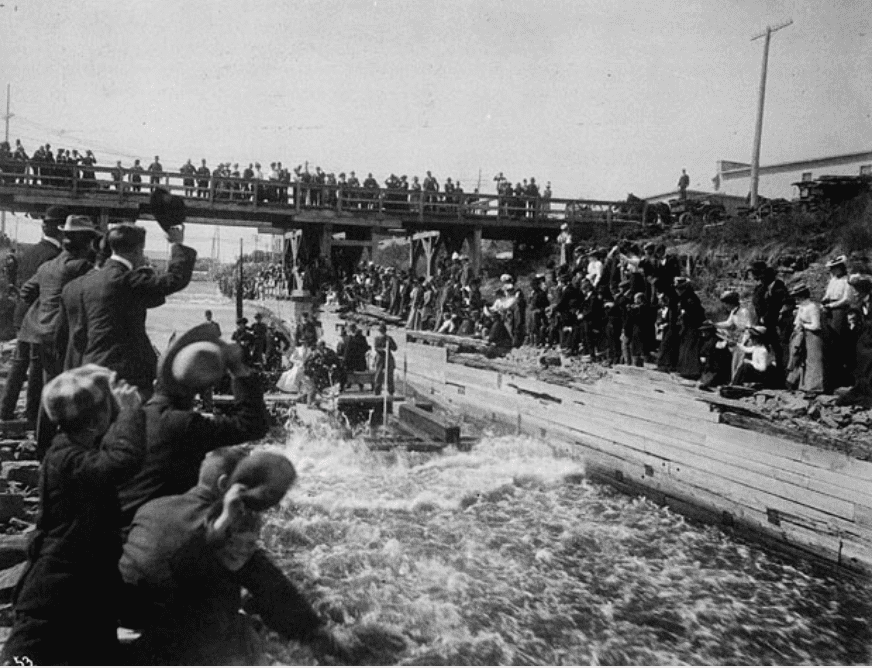 The Duke of Cornwall and York and the Royal Party taking a ride on a crib through the Chaudière log slide, 1901, Charles Berkley fonds, Library and Archives Canada, ID No. 3294381.
The Duke of Cornwall and York and the Royal Party taking a ride on a crib through the Chaudière log slide, 1901, Charles Berkley fonds, Library and Archives Canada, ID No. 3294381.
Owing to waning demand for square timber, and a declining supply of big pine trees, fewer and fewer timber rafts made their way from Ottawa to Quebec City by the end of the nineteenth century. The few that did attracted much attention as the big timber rafts were broken up to make the trip through the government timber slide at the Chaudière Falls before being reassembled below the Parliament buildings for the next leg in their journey to the old capital. Timber rafting became a tourist and spectator sport. An exhilarating trip through the timber slide on a crib became a de rigueur experience for visiting dignitaries. In 1901, the Duke of Cornwall and York, later King George V, took the plunge, just as his father had in 1860.
The last square timber raft to leave for Quebec City from Ottawa began its journey in mid-June 1908 from the upper reaches of the Ottawa River. The Ottawa Citizen reported that the largest raft in years, totalling 135 cribs, owned by J.R. Booth, had descended the Black River in Quebec. The newspaper advised people who wished to see the sight of it shooting the Grand Calumet slide upstream on the Ottawa River to take the CPR train to Campbell’s Bay and the stage to Bryson, Quebec.
On or about 8 July 1908, this last timber raft was ready for its transit through the government slide at the Chaudière Falls. We know this date from newspaper accounts of an inquiry into a hit and run accident that occurred in Ottawa. The suspect, a hackman, F.J.X. Lascelles, had been hired on 8 July to work on Booth’s timber raft going to Quebec City. Another newspaper account two days later advised people to go watch the running of the cribs through the Chaudière timber slide then underway as it was “probably the last [timber raft] that will ever pass down the Ottawa to Quebec City.” Hundreds of spectators took the newspaper’s advice to watch the event. After passing through the slide, the cribs were reassembled below the Parliament buildings into the log raft for its voyage to Quebec City under the direction of pilot Ephrem Lalonde, a raftsman of more than forty years’ experience.
The Ottawa Citizen remarked that this was the end of the adventurous method of transporting timber which had been the most picturesque feature of the timber industry. Subsequent loads of timber were transported by rail.
After peaking during the beginning the twentieth century, the Ottawa Valley timber industry entered a long decline as its supply of wood dwindled. By the mid-1920s, it was estimated that less than four percent of the Ottawa Valley’s original, old-growth forest remained, consisting of not more than 10 billion feet of pine of saw-sized timber, with a further 5 billion feet of other soft woods and 4 billion feet of hard woods. Secondary growth of soft and hard woods was deemed suitable only for pulp and firewood.
Lumbermen looked back in dismay at the wasteful practices of the past. Squaring logs led to the wastage of more than one-third of the wood. Giant hemlocks were cut down solely for their bark used for tanning leather, the wood left to rot where the trees were felled. Land clearances for farms destroyed countless acres of valuable timber. The dead branches and brush from cut trees also provided the fuel for massive forest fires that destroyed valuable stands of timber.
Today, the lumber and paper mills of Ottawa-Hull are mostly gone. The J.R. Booth Company was bought out by E.B. Eddy in 1943, the first of many mergers and closures. Domtar acquired the E.B. Eddy mills in Ottawa and Gatineau in 1998, and permanently closed them in 2005 and 2007, respectively. The site of the big Eddy pulp mill on the north shore of the Ottawa River across from Parliament Hill is now the location of the Canadian Museum of History. All that is left is the former Eddy paper mill on Laurier Street in the Hull sector of Gatineau. The mill has been owned by Kruger, a Quebec-based forest product company, since 1997.
Although the lumber industry was the backbone of the Ottawa economy for close to two hundred years, providing jobs for thousands, the prosperity that it generated came at a high environmental cost. The industry irrevocably altered the landscape of the Ottawa Valley with the destruction of virtually all of its original woodland. Along with it went the traditional way of life of the Indigenous people of the Ottawa Valley, who never ceded ownership of its territory to European setters. The industry also had serious negative consequences for the Ottawa River. Dams built to control water levels to facilitate the transport of logs and to power the sawmills disturbed fish habitats. Sunken logs, and saw dust, routinely dumped into the river, along with chemicals from the pulp and paper mills, and untreated city effluents, polluted the water, killed fish, and brought disease.
Fortunately, with the closure of most of the mills and more effective treatment of city sewage and runoff, water quality in the Ottawa River is improving. However, the extent of the improvement is not known. According to the Ottawa Riverkeeper, water quality monitoring is piecemeal throughout the Ottawa River watershed, and there is no program in place to monitor the quality of water in the Ottawa River over time.
A lasting legacy of Ottawa’s lumbering past is the ring dam at the Chaudière Falls. Once used to make electricity to drive the sawmills, it now produces clean energy to help power downtown Ottawa. While the once dirty industrial area has been greened and opened to the public, the dam’s continued presence remains controversial.
Forestry continues in the Ottawa Valley, though on a much-reduced scale from its glory days. Its focus today is on sustainable forestry practices that respect not only the economic value of the forest but also its cultural and ecological significance.
Sources:
Canadian Museum of History, 2020. The Timber Trade, https://www.historymuseum.ca/cmc/exhibitions/hist/canp1/ca14eng.html.
Hirsch, R. Forbes, 1985. The Upper Canada Timber Trade: a sketch, Bytown Pamphlet No. 14, Historical Society of Ottawa.
Ottawa Citizen, 1908. “Big Raft Coming,” 15 June.
——————, 1908. “Comment,” 10 July.
——————, 1908. “Police Doing Clever Work,” 17 July.
——————, 1926. “For Over One Hundred Years District Has Been Greatest Lumber Producer In Canada,” 16 August.
——————, 1936. “Had Exciting Adventure On A Journey To Quebec On A Raft,” 15 February.
——————, 2006. “Kruger to change Scott names as Kimberly-Clark deal ends,” 11 October.
Ottawa Journal, 1976. “Great timber trade began on Hull side,” 27 September.
Ottawa Riverkeeper, 2020. Water Quality and Quantity, https://www.ottawariverkeeper.ca/ottawa-river-water-quality/.
OttawaRiver.org, 2005. A Background Study for Nomination of the Ottawa River Under the Canadian Heritage Rivers System – 2005, https://ottawariver.org/pdf/01-intro.pdf.
Outaouais’ Forest History, 2020. http://www.histoireforestiereoutaouais.ca/en/.
Whitton, Charlotte, 1967. “The Ottawa: My land of the white pine tree,” Ottawa Citizen, 27 June.
Story written by James Powell, the author of the blog Today in Ottawa's History.
Retired from the Bank of Canada, James is the author or co-author of three books dealing with some aspect of Canadian history. These comprise: A History of the Canadian Dollar, 2005, Bank of Canada, The Bank of Canada of James Elliott Coyne: Challenges, Confrontation and Change,” 2009, Queen’s University Press, and with Jill Moxley, Faking It! A History of Counterfeiting in Canada, 2013, General Store Publishing House, Renfrew, Ontario. James is a Director of The Historical Society of Ottawa.



